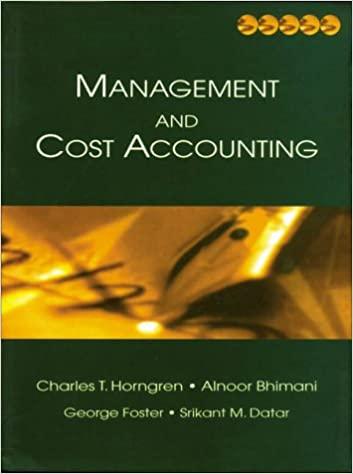Question
Question 1: Which of the following is not included in product cost under marginal costing? A. direct labour B. direct materials C. fixed overhead D.
Question 1:
Which of the following is not included in product cost under marginal costing?
A. direct labour
B. direct materials
C. fixed overhead
D. variable overhead
Question 2:
A plc makes a single product, which it sells for 40 per unit. Fixed costs are 84,600 per month and the product has a contribution ratio of 40%. In a month when actual sales were 244,000, A plcs margin of safety is:
- 211,500
- 159,400
- 32,500
- 366,000
Question 3:
A furniture manufacturing firm operates a job costing system. Production overhead is absorbed at the rate of 3.50 per machine hour. In order to allow for non-production overhead costs and profit, a mark-up of 55% of prime cost is added to the production cost when preparing price estimates. The estimated requirements of job number 699 are as follows:
Direct materials 650
Direct labour 260
Machine hours 120
The estimated price notified to the customer for job number 699 will be?
- 965
- 1,330
- 1,141
- 1,830
Question 4:
Which of the following statements is true?
- The total variable cost varies with a measure of activity.
- A variable cost is an unavoidable cost.
- A variable cost is not relevant for decision-making.
- A variable cost becomes fixed in the long run.
Question 5:
A company manufactures and sells bicycles for 55 each. They plan to sell 4,500 bicycles in the coming twelve months. The variable and fixed manufacturing costs of making the bicycles are estimated at 31 per bicycle and 84,000 respectively. Indicate which of the following statements is correct:
- The breakeven point is 4,500 bicycles and the margin of safety is 0 bicycles.
- The margin of safety is 300 bicycles and the breakeven point is 4,800 bicycles.
- The breakeven point is 3,300 bicycles and the margin of safety is 1,200 bicycles.
- The margin of safety is 1,000 bicycles and the breakeven point is 3,500 bicycles.
Question 6:
Which ONE of the following costs would NOT be classified as a production overhead cost in a beer making company?
- The depreciation of equipment located in the materials store
- The salary of the factory manager
- The cost of renting the factory building
- The cost of the beer ingredients
Question 7:
A company has been using an overhead absorption rate of 10.50 per machine hour in its Assembly department. During the year the overhead expenditure amounted to 28,445 and 2,410 machine hours were incurred.
Which of the following is correct?
- Overheads were over-absorbed by 3,140
- Overheads were under-absorbed by 3,140
- Overheads were under-absorbed by 31,400
- Overheads were over- absorbed by 31,400
Question 8:
A products total production cost will include:
- Prime cost plus non production overhead
- Prime costs plus indirect production overhead
- Prime cost plus variable non-production overheads
- Prime costs plus indirect production overhead plus any relevant tax
Question 9:
Tandem Trucking spends 11,455 per month to run their business. They make an average of 420 deliveries per month at a fee of 55.00 per delivery. Rounded to the nearest percent, what is Tandems monthly return on their 11,455 investment?
- 101%
- 102%
- 103%
- 104%
Question 10:
John is a security officer with a manufacturing company. He is paid 1.500 a month. Johns salary can be considered as:
- Indirect labour
- Direct labour
- Prime Cost
- Production cost
Step by Step Solution
There are 3 Steps involved in it
Step: 1

Get Instant Access to Expert-Tailored Solutions
See step-by-step solutions with expert insights and AI powered tools for academic success
Step: 2

Step: 3

Ace Your Homework with AI
Get the answers you need in no time with our AI-driven, step-by-step assistance
Get Started


